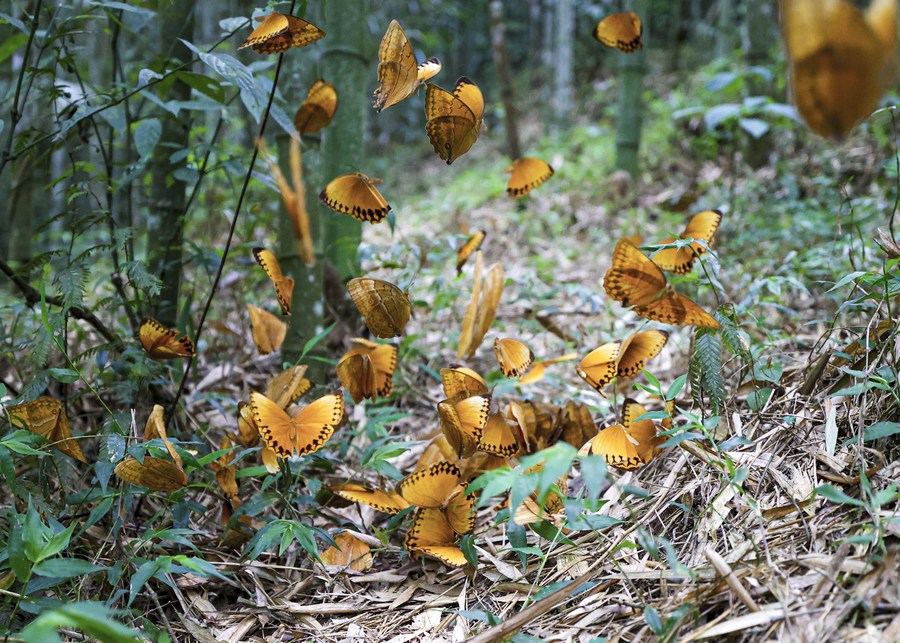Helping butterflies spread their wings in China's Yunnan
Xinhua | Updated: 2023-05-30 14:18

KUNMING -- In late spring and early summer each year, tens of millions of butterflies gracefully emerge from their chrysalises in the butterfly valley in Southwest China's Yunnan province. For butterfly expert Yang Zhenwen, it is the busiest time of the year, but one he greets with great enthusiasm.
Before the break of dawn, Yang has already arrived at the observation point, diligently tending to the needs of the awakening butterflies. With utmost care, he sprays nutrient solutions to nourish these delicate creatures, all the while sharing his wisdom on butterfly conservation with tourists captivated by the enchanting "butterfly explosion."
"Due to warmer temperatures, the 'butterfly explosion' this year occurred slightly earlier than usual, and the size of the butterflies is larger than in previous years," said 46-year-old Yang, curator of the butterfly valley museum in Jinping Miao, Yao, and Dai autonomous county, Honghe Hani and Yi autonomous prefecture.
"We expect that there will be about 80 million to 100 million butterflies in the valley during this year's 'butterfly explosion', which is estimated to last until around June 10," said Yang, who also serves as a dedicated monitor at the butterfly valley.
According to Yang, in the valley, more than 320 butterfly species have been identified in specimens or photographs, including the rarest, most primitive, largest and smallest butterflies in China.
Yang explained that the primary species behind the "butterfly explosion" is Stichophthalma, which completes one generation per year.
Zhou Xuesong, an expert in animal and plant protection at Southwest Forestry University, affirms that the butterfly valley maintains a warm and humid climate throughout the year, with a forest coverage rate of 70 percent and an altitude ranging from 105 meters to 3,012 meters. "Such a diverse ecosystem provides an ecological environment suitable for butterflies," said Zhou.
Furthermore, Yang revealed that the butterfly valley encompasses approximately 3,067 hectares of host plants for the Stichophthalma. The abundant food source is capable of sustaining around 1 billion Stichophthalma caterpillars, surpassing the current caterpillar population significantly.
Besides Yang, many local villagers have also embraced the role of butterfly guardians. However, the journey toward achieving human-butterfly harmony was far from easy.
Some two decades ago, the villagers had little awareness of butterfly conservation, believing wrongly that butterflies could threaten their food crops. They viewed them as pests that should be eliminated.
In 1998, Yang embarked on his journey at the agricultural science station in Ma'an'di Township, the very place where the butterfly valley is nestled.
"It was there that I confronted a recurring dilemma -- the local villagers, seeking to protect their crops, would often plead for pesticides to eradicate the butterflies," he said. "However, my genuine affection for these creatures compelled me to persistently dissuade them from harming the delicate insects."
A significant turning point occurred in 1998, when two butterfly experts visited the township, dedicating themselves to the cause of conserving local butterflies. Their research endeavors sparked a transformative shift towards joint conservation.
"We explained to the local villagers the mutual benefits between the Stichophthalma and the bamboo forest. Stichophthalma not only refrains from causing damage but can also aid in ventilation and promote the healthy growth of bamboo shoots," said Liu Jiazhu, one of the experts.
Through the relentless efforts of scholars and local authorities, the Honghe Butterfly Valley was opened to the public in 2010. Since then, it has welcomed more than 1.9 million visitors. The county government has implemented regulations for the protection and management of the valley, and has invited experts and scholars to carry out scientific investigations.
Now, the development of ecotourism relying on butterfly resources has successfully transformed the once impoverished township.
More villagers have started engaging in butterfly breeding. "Protecting the forests, conserving water sources and preserving butterflies have become conscious actions within the local community," said Yang.
He describes the butterfly valley as a "dream-making machine." Not only does it showcase picturesque landscapes akin to dreams, but it also perpetually extends the "butterfly dream" of harmonious coexistence between humans and nature.
























